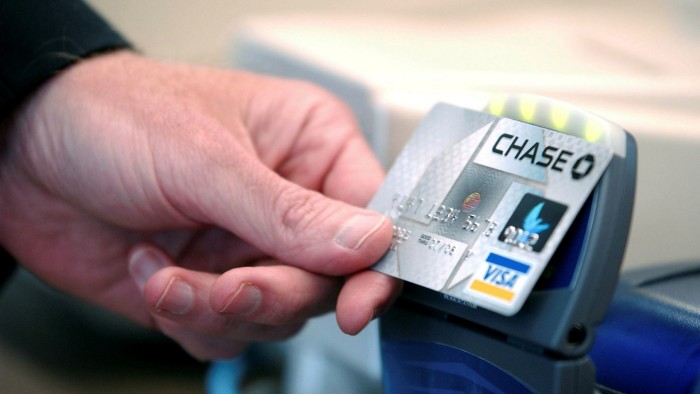Card lenders show faith in US consumer as they hunt for new borrowers

Roula Khalaf, Editor of the FT, selects her favourite stories in this weekly newsletter.
Leading US credit card lenders are signalling their confidence in the American consumer, stepping up marketing efforts to attract new borrowers even as the economy slips into a technical recession.
After rising 47 per cent in the first quarter, the volume of paper and digital mail solicitations sent by US credit card issuers increased again in the second quarter, according to preliminary data from marketing research firm Competiscan, putting it on track to reach a record high this year.
The wave of offers follows an 85 per cent surge last year from the depressed levels of 2020 and comes as many big card issuers said during their second-quarter earnings reports this month that they were increasing marketing spending.
JPMorgan Chase, the largest US card issuer, highlighted the ferocity of the competition for borrowers when it blamed higher customer acquisition costs for a 45 per cent fall in second-quarter card income.* Capital One, the second-largest issuer, said its quarterly marketing expenses rose 62 per cent from last year’s levels and pledged to remain aggressive.
“We continue to see opportunities to book accounts and loans that can generate resilient and attractive returns and we continue to lean into marketing to drive growth,” Capital One chief executive Richard Fairbank said, calling the competition “more intense than pre-pandemic levels”.

The increase in marketing activity is particularly noteworthy at this stage of the economic cycle. During uncertain times, lenders typically send out fewer card offers — targeting potential borrowers with the highest credit scores — and focus on selling premium cards or making other offers to current customers.
However, even as the Federal Reserve raises interest rates to bring down the highest inflation rate in more than four decades, credit card lenders believe they have room to increase the size of their loan books because unemployment is low and consumer balance sheets appear healthy.
Credit card balances held by the seven largest issuers — JPMorgan, Capital One, Citigroup, Bank of America, American Express, Discover and Synchrony — rose 13 per cent to $739.8bn compared with last year, but remain about 9 per cent lower than they were at the end of 2019.
American Express last week raised its already bullish revenue outlook for the year as it reported higher-than-expected earnings and said its annual marketing spending would come in above its prior guidance of $5bn.
“I don’t see [a recession] in my numbers at all,” chief executive Stephen Squeri told Yahoo Finance. “It’s really hard for me to get my head around that in quarter three or quarter four we’re going to have a big slowdown.”
To attract new customers, issuers are embracing flashy tactics. Last month, Amex rolled out a limited-edition card made from the scrap metal of retired planes. Sign-on bonuses tied to travel have become more generous, although consumers so far are showing a preference for cashback cards.
Many of the marketing efforts are targeting so-called “revolvers”, or borrowers who carry a balance from month to month instead of paying their statements off in full.
During the first quarter, there was a 62 per cent increase in the volume of balance transfer offers that would enable consumers to consolidate debt on to a credit card interest-free for a time, Competiscan said. The terms are also getting more generous. The interest-free period rose on average to 16 months this year from 14 months in 2021.
Sara Rathner, an analyst at NerdWallet, a personal finance website, said the combination of growing balances and rising interest rates could land consumers in trouble.
“If you have credit card debt currently, or you’re taking on debt for a large upcoming purchase, interest rates are high, they are getting higher,” Rathner said. “It can spiral out of control pretty quickly.”
Complicating the task for lenders is the difficulty that they face in gauging the impact of government stimulus and debt forbearance programmes on consumers over the longer term.
“You have seen a dislocation between what had been very correlated metrics,” said Brian Doubles, chief executive of Synchrony, the largest US store credit card issuer, which increased its marketing spending by 18 per cent last quarter, in line with pre-pandemic levels. “That’s really because of the effects of the stimulus and the forbearance that comes through.”
Lenders argue that new targeting tools and data analytics have made it easier to lend through a downturn without taking outsized losses.
Many lenders now analyse factors such as education, employment history and checking account balances in addition to the traditional credit score to determine creditworthiness, which increases the pool of potential borrowers, said Megan Cipperly, senior director of client services at Competiscan.
Incentives such as rate discounts for setting up automatic payments or making several consecutive on-time payments are also becoming more popular for unsecured loans.
“It reduces their chance of having delinquencies and then it creates a positive customer-lender relationship,” Cipperly said. “That’s a great strategy if we’re heading into a recession.”
*This story has been amended to clarify that the second quarter decline at JPMorgan was in card income, not profit
Comments